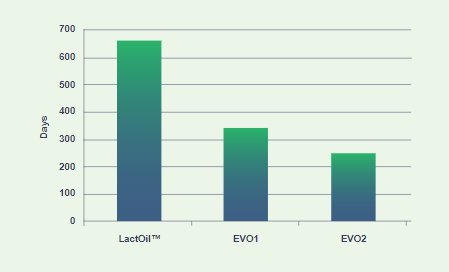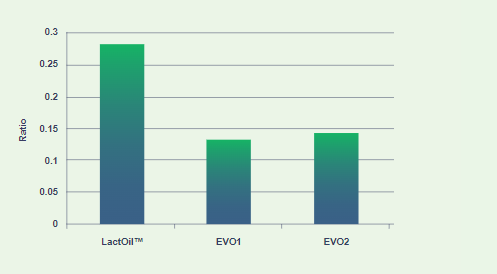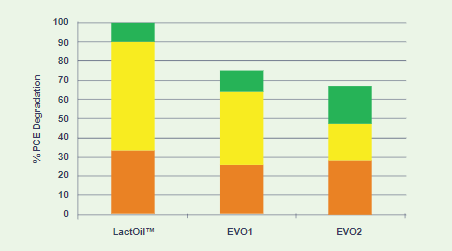Knowde Enhanced TDS
Identification & Functionality
- Chemical Family
- Technologies
Features & Benefits
- Industrial Additives Features
- Benefits
High Fermentable Content
- High organic content (over 95%) provides up to 30% more fermentables than standard emulsified vegetable oils.
Easy Material Handling- Low viscosity; readily mixes with water; no high shear mixing needed
- Low injection pressure.
- Longer shelf life
Increased Subsurface Distribution- Thermodynamically stable
- Small particle size
- Average particle size < 1 micron
- High emulsion stability allows for greater subsurface transport
Increased Degradation Rates- Provides sustained lactate for accelerated metabolism
Higher Efficiency- Increased contaminant degradation per unit of fermentable product injected as compared to standard EVO
Contaminants Treated- Chlorinated solvents, nitrates, perchlorate, RDX, metals, trichloropropane, mine impacted water
Treatment Applications- Permanent wells, direct push, excavation backfill, bedrock
Applications & Uses
- Applicable Processes
- Uses
Contaminants Treated
- Chlorinated solvents
- Perchlorate
- RDX
- Reduction of metals
Treatment Configurations- Source area treatment
- Biobarrier treatment
- Plume-wide treatment
Delivery Methods- Permanent injection wells
- Direct push methods
Properties
- Miscible in
- Water, Self emulsifies
- Typical Properties
- Viscosity
Temperatures below 50°F will cause the material to become more viscose, and may solidify to the consistency of bacon grease. If this should happen, move the material to a warmer location and mix.
| Value | Units | Test Method / Conditions | |
| pH (Buffered to) | min. 6.5 | - | - |
| Specific Gravity (at 20°C) | 0.95 | - | - |
| Zeta Potential | -83.0 | mV | - |
| Particle Size | max. 1 | microns | - |
| Viscosity (at 70°F) | 25.0 | cPs | - |
Technical Details & Test Data
- Microcosm Study results
Longevity : LactOil® has an estimated electron donor longevity that is 2-3 times greater than other commercially available emulsified vegetable products.

Efficiency : When compared to other commercially available emulsified vegetable oil products, LactOil® has a higher ratio of electrons stimulating dechlorination than consumed by methanogenesis and acetogenesis.
Kinetics : LactOil® can degrade PCE to cis-DCE, vinyl chloride, and ethene quicker than other commercially available emulsified vegetable oil products.
Particle Size Analysis : A particle size analysis shows LactOil® particles are consistently smaller than 1 micron. Small particle size and stability allow for physical transport of material in the aquifer.

Packaging & Availability
- Packaging Type
- Packaging Information
- 5-gallon pails
- 55-gallon polyethylene drums
- 265-gallon IBC totes
- Tankers
Storage & Handling
- Storage & Handling Information
- Store unopened under dry conditions at temperatures between 50°F and 85°F.
- Diluted product should be used within 3 days to avoid microbial growth and activity which may cause gas buildups in containers and visible growth which may foul equipment.
- Following injection of material, wells should be flushed with clean water to prevent microbial growth.

